
FOREWORD
MAINTENANCE STANDARD TERMINOLOGY
WA470-6, WA480-6
00-9
12
2.
Standard clearance and standard value
•
The clearance made when new parts are assembled is called the “standard clearance“, which is indicated by the range
from the minimum clearance to the maximum clearance.
•
When some parts are repaired, the clearance is generally adjusted to the standard clearance.
•
A value of performance and function of new products or equivalent is called the “standard value“, which is indicated
by a range or a target value.
•
When some parts are repaired, the value of performance/function is set to the standard value.
3.
Standard interference
•
When the diameter of a hole of a part shown in the given standard size and tolerance table is smaller than that of the
mating shaft, the difference between those diameters is called the “interference”.
•
The range (A – B) from the difference (A) between the minimum size of the shaft and the maximum size of the hole
to the difference (B) between the maximum size of the shaft and the minimum size of the hole is the “standard inter-
ference”.
•
After repairing or replacing some parts, measure the size of their hole and shaft and check that the interference is in
the standard range.
4.
Repair limit and allowable value or allowable dimension
•
The size of a part changes because of wear and deformation while it is used. The limit of changed size is called the
“repair limit”.
•
If a part is worn to the repair limit, it must be replaced or repaired.
•
The performance and function of a product lowers while it is used. A value which the product can be used without
causing a problem is called the “allowable value” or “allowable dimension”.
•
If a product is worn to the allowable value, it must be checked or repaired. Since the permissible value is estimated
from various tests or experiences in most cases, however, it must be judged after considering the operating condition
and customer's requirement.
5.
Clearance limit
•
Parts can be used until the clearance between them is increased to a certain limit. The limit at which those parts can-
not be used is called the “clearance limit”.
•
If the clearance between the parts exceeds the clearance limit, they must be replaced or repaired.
6.
Interference limit
•
The allowable maximum interference between the hole of a part and the shaft of another part to be assembled is called
the “interference limit”.
•
The interference limit shows the repair limit of the part of smaller tolerance.
•
If the interference between the parts exceeds the interference limit, they must be replaced or repaired.



































